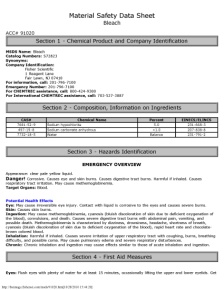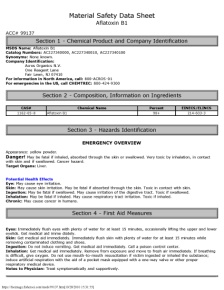Mycotoxins and Bleach
- Posted on: December 5, 2010
When dealing with mold, mold contamination and clean up, inevitably a couple of terms will enter the conversation: mycotoxin and bleach. Consultants probably deal with this situation just as much if not more than we do at the lab. But any IAQ professional who has presented a client a lab report with positive mold results, has had this same conversation over and over. How many times have you heard “well, I’m just going to … or can’t I just pour some bleach on it?” Too many times to count right?
First we want to make it clear that we are not saying that all mold produces toxins, just because a mold report is issued with mold detected, one can not assume there are mold toxins present. This tid bit is nothing new for the mold professionals however, it needs to be said just in case a non mold professional reads our blog(if this is you, hello, and thank you for reading!)
I thought it might be interesting to compare the MSDS sheets for a mycotoxin and bleach. Then next time the subject comes up, maybe you will have taken away a factoid or two to pepper your answer with.
Let’s refresh our vocabularies with a couple basic definitions. Mycotoxin is a toxin or poison that is produced by fungi. While, mycotoxin is broad term encompassing many individual toxins produced by fungi, for comparison sake we have selected one of the more common types, aflatoxin. The topic of mycotoxins is discussed in greater detail in a separate blog post called Mycotoxins: a closer look
Factoid: At least 13 different types of aflatoxin are produced in nature with aflatoxin B1 considered as the most toxic(6).
I think we all are familiar with bleach, most of us have the common cleaning agent in our homes, but by definition according to Encarta, bleach is a chemical that removes or whitens color or staining and also cleans and disinfects.
Below I created a chart that shows the health effects of both Mycotoxin (Aflatoxin) and Bleach, and placed them side by side for ease of comparison.
Mycotoxin (aflatoxin) Bleach
| Danger | May be fatal if inhaled, absorbed through the skin or swallowed. Very toxic by inhalation, in contactwith skin and if swallowed. Cancer hazard. | Corrosive. Causes eye and skin burns. Causes digestive tract burns. Harmful if inhaled. Causesrespiratory tract irritation. May cause methemoglobinemia. |
| Target organ | Liver. | Blood. |
| Eye | May cause eye irritation. | May cause irreversible eye injury. Contact with liquid is corrosive to the eyes and causes severe burns. |
| Skin | May cause skin irritation. May be fatal if absorbed through the skin. Toxic in contact with skin. | Causes skin burns. |
| Ingestion | May be fatal if swallowed. May cause irritation of the digestive tract. Toxic if swallowed | May cause methemoglobinemia, cyanosis (bluish discoloration of skin due to deficient oxygenation ofthe blood), convulsions, and death. Causes severe digestive tract burns with abdominal pain, vomiting, and possible death. Methemoglobinemia is characterized by dizziness, drowsiness, headache, shortness of breath, cyanosis (bluish discoloration of skin due to deficient oxygenation of the blood), rapid heart rate and chocolatebrown colored blood. |
| Inhalation | May be fatal if inhaled. May cause respiratory tract irritation. Toxic if inhaled. | Harmful if inhaled. Causes severe irritation of upper respiratory tract with coughing, burns, breathingdifficulty, and possible coma. May cause pulmonary edema and severe respiratory disturbances. |
| Chronic | May cause cancer in humans. | Chronic inhalation and ingestion may cause effects similar to those of acute inhalation and ingestion |
Clearly both are serious chemicals and should be treated as such. In case you haven’t read what OSHA or the EPA suggests continue reading:
OHSA(3): Use of Biocides
| Hard surface, porous flooring§ (Linoleum, ceramic tile, vinyl) |
|
| Non-porous, hard surfaces (Plastics, metals) |
|
4). http://www.epa.gov/mold/table1.html
5). Aldrich Catalog Handbook of Fine Chemicals, 1988-1989, pg.40
6). http://www.medterms.com/script/main/art.asp?articlekey=10796





